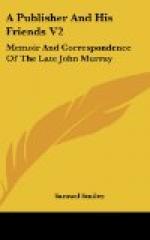Thus pressed by his correspondents, Mr. Murray did his best to rescue the Quarterly from failure. Though it brought him into prominent notice as a publisher, it was not by any means paying its expenses. Some thought it doubtful whether “the play was worth the candle.” Yet Murray was not a man to be driven back by comparative want of success. He continued to enlist a band of competent contributors. Amongst these were some very eminent men: Mr. John Barrow of the Admiralty; the Rev. Reginald Heber, Mr. Robert Grant (afterwards Sir Robert, the Indian judge), Mr. Stephens, etc. How Mr. Barrow was induced to become a contributor is thus explained in his Autobiography. [Footnote: “Autobiographical Memoir of Sir John Barrow,” Murray, 1847.]
“One morning, in the summer of the year 1809, Mr. Canning looked in upon me at the Admiralty, said he had often troubled me on business, but he was now about to ask me a favour. ’I believe you are acquainted with my friend William Gifford?’ ‘By reputation,’ I said, ‘but not personally.’ ‘Then,’ says he, ’I must make you personally acquainted; will you come and dine with me at Gloucester Lodge any day, the sooner the more agreeable—say to-morrow, if you are disengaged?’ On accepting, he said, ’I will send for Gifford to meet you; I know he will be too glad to come.’
“‘Now,’ he continued, ’it is right I should tell you that, in the Review of which two numbers have appeared, under the name of the Quarterly, I am deeply, both publicly and personally, interested, and have taken a leading part with Mr. George Ellis, Hookham Frere, Walter Scott, Rose, Southey, and some others; our object in that work being to counteract the virus scattered among His Majesty’s subjects through the pages of the Edinburgh Review. Now, I wish to enlist you in our corps, not as a mere advising idler, but as an efficient labourer in our friend Gifford’s vineyard.’”
Mr. Barrow modestly expressed a doubt as to his competence, but in the sequel, he tells us, Mr. Canning carried his point, and “I may add, once for all, that what with Gifford’s eager and urgent demands, and the exercise becoming habitual and not disagreeable, I did not cease writing for the Quarterly Review till I had supplied no less, rather more, than 190 articles.”
The fourth number of the Quarterly, which was due in November, was not published until the end of December 1809. Gifford’s excuse was the want of copy. He wrote to Mr. Murray: “We must, upon the publication of this number, enter into some plan for ensuring regularity.”
Although it appeared late, the fourth number was the best that had yet been issued. It was more varied in its contents; containing articles by Scott, Southey, Barrow, and Heber. But the most important article was contributed by Robert Grant, on the “Character of the late C.J. Fox.” This was the first article in the Quarterly, according to Mr. Murray, which excited general admiration, concerning which we find a memorandum in Mr. Murray’s own copy; and, what was an important test, it largely increased the demand for the Review.




